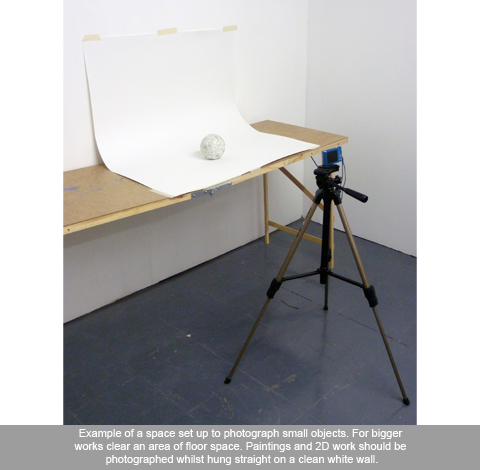Tips for documenting your work Part 1 : Introduction

Back to UAL Photography

TIPS FOR PHOTO DOCUMENTING YOUR WORK PART 1 : INTRODUCTION
See part 1 - Tips for documenting your work : Introduction
See part 2 - Tips for documenting your work : Lighting
See part 3 - Tips for documenting your work : Composition
Record your work as you go!
It is important to document all your work. You never know if a work you decide not to document will be become important for future projects. Documentation lends professionalism and integrity to your practice, showing you take your work seriously enough to record it efficiently and accurately. Recording your work at each stage of making helps you to remember how you got to the final piece and helps you to build your own personal visual library of processes and techniques. Recording your final piece means you have a reference of it before it gets damaged, lost or disintegrates because it is made of perishable materials such as jelly. If your work is a temporary installation or a one-off performance plan ahead to make sure it can either be photographed or filmed.
Before you pick up your camera
Think about the work you are photographing Each piece of work will need unique consideration as to how it should be photographed. Does your piece need to be photographed in a specific location? Do you need a completely blank background? What colours are in your piece? Is the background of the photo going to clash with your piece?
Organise a space to photograph your work You do not need a photographic studio to document work. Set up an area that has a good amount of natural light and a neutral background, preferably a wall painted white. Any batches of strong colour on walls around the photographing area can affect the lighting of the work and be distracting to your piece.
Clear away any objects or paper that is going to interfere with taking photos of your piece. If you need to shoot with a grey, black or white background tape up some card for your piece to sit on. Preferably curve the paper so that it provides a seamless backround with no edges or corners in sight.
Always use a tripod: this gives the sharpest possible shots and stops small movements blurring the image. The camera is also then set up making it possible to take several shots in the exact same position.
Camera functions
You can document your work well with a compact digital camera if you don't have a digital SLR. Phone cameras are getting better in quality and are great for documenting processes in your studio quickly but for documenting final pieces try to use a camera as it will have a fitting to attach it to a tripod.
Use specific shooting functions where appropriate. If you taking close up detail shots use the macro setting (usually a picture of a small flower). Adjust the white balance to match the light source you are using, e.g. daylight, shade, tungsten etc when shooting, this will help to gain an image with colour true to your piece and will avoid those extremely blue or yellow photographs. Play around with your camera, explore the menu system, often there are many options and functions that can help you take better photographs.
Playback images on the LCD after you have taken them, to be certain they are in focus and the exposure is as close as possible to correct. If you can enlarge the image, do, so you can check for sharp focus and detail.
Archive
Its important to file your images efficiently so you can find them and people viewing them know who they belong to and what they are looking at. Save digital files as jpegs with your name/title of work/year of work.
| Attachment | Size |
|---|---|
| Photo_Documentation.pdf | 8.96 MB |

This collection, Tips for documenting your work Part 1 : Introduction, by A Pearson is licensed under a Creative Commons Attribution-NonCommercial-ShareAlike 3.0 Unported license.


